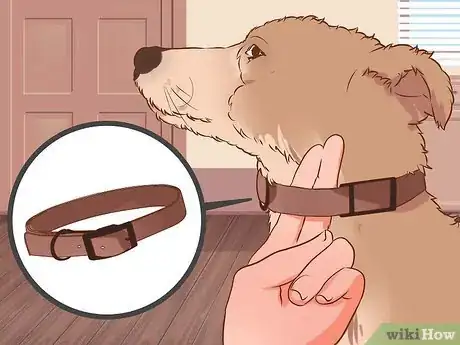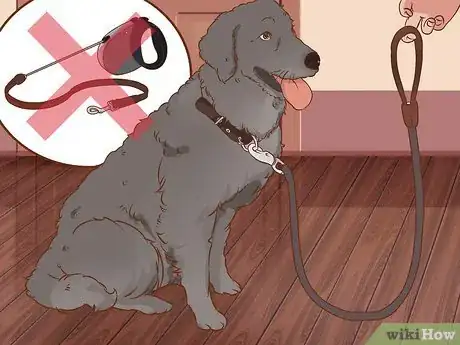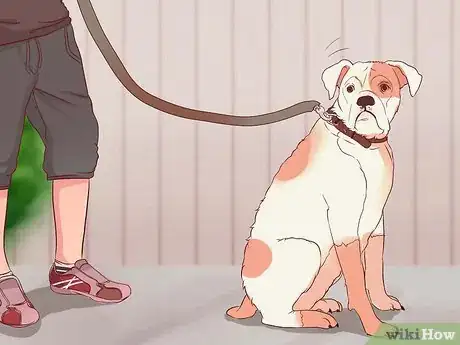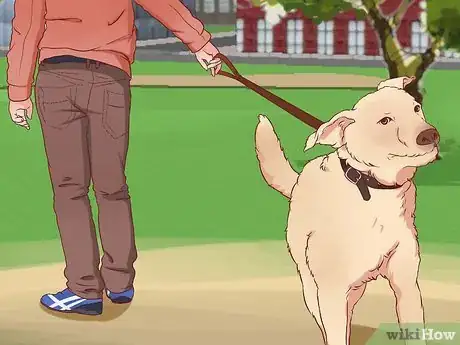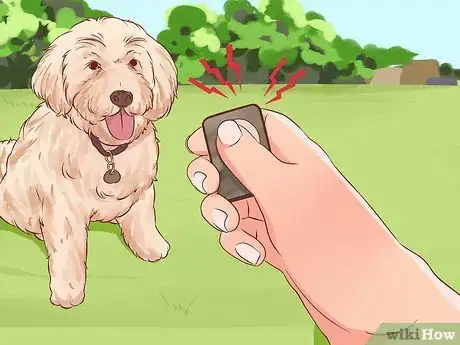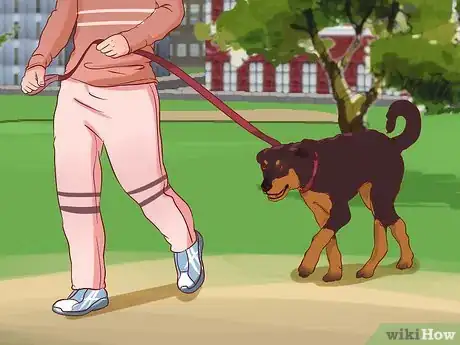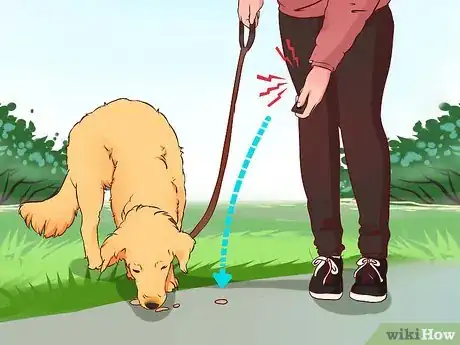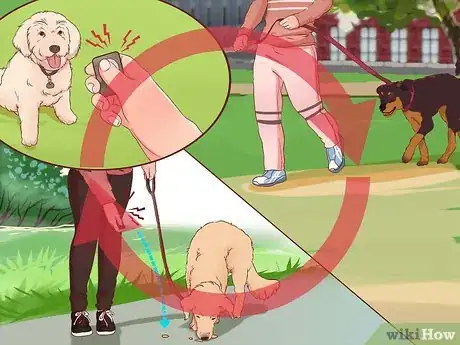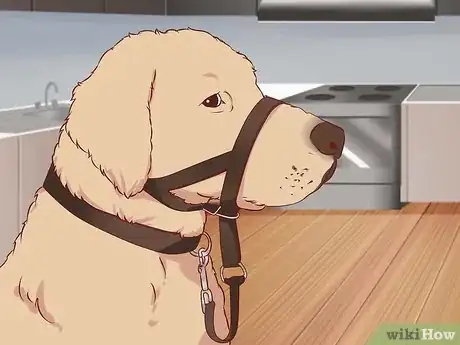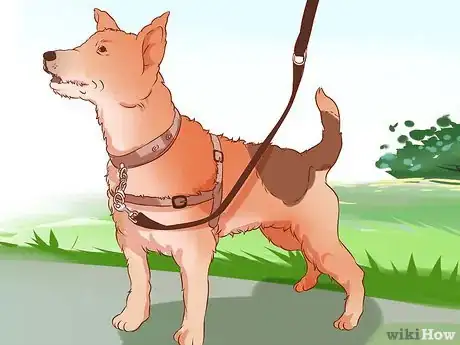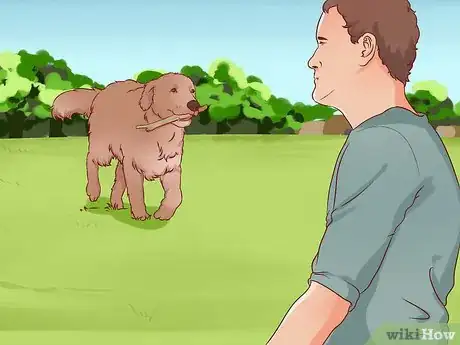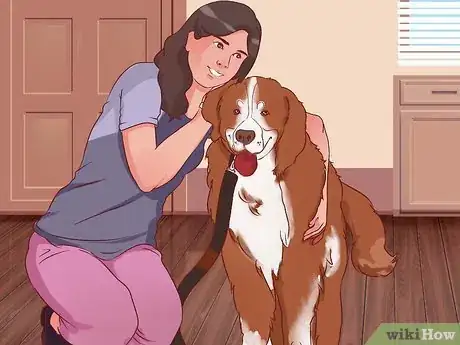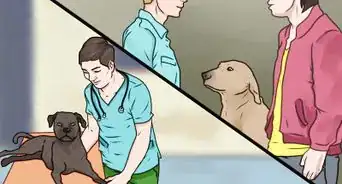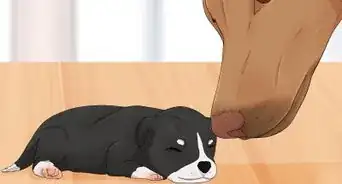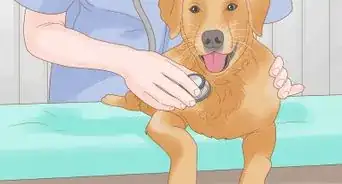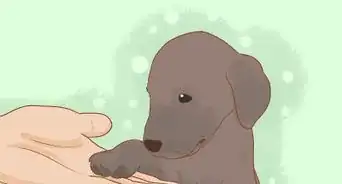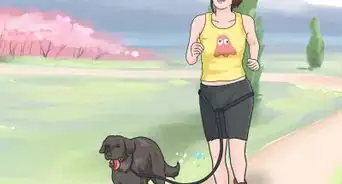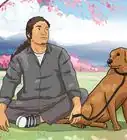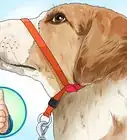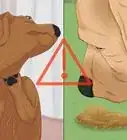This article was co-authored by Pippa Elliott, MRCVS. Dr. Elliott, BVMS, MRCVS is a veterinarian with over 30 years of experience in veterinary surgery and companion animal practice. She graduated from the University of Glasgow in 1987 with a degree in veterinary medicine and surgery. She has worked at the same animal clinic in her hometown for over 20 years.
wikiHow marks an article as reader-approved once it receives enough positive feedback. This article received 12 testimonials and 91% of readers who voted found it helpful, earning it our reader-approved status.
This article has been viewed 572,876 times.
When taking a dog for a walk, you should guide the path of the dog —not vice versa. Besides being a minor embarrassment for its human owner, a dog who incessantly pulls at its leash can represent a safety risk to itself and others. For example, such a dog may come free of its harness, at which point the owner may have no way to keep it from running into a dangerous area, like a street. Because of this, learning how to keep a dog under control while on a leash is a wise decision for nearly all dog owners.
Steps
Using the "Be a Tree" Method
-
1Use a proper collar. Be sure that your dog has a comfortable collar that fits it properly. The collar shouldn’t be so tight that it is choking the dog, but should be tight enough so that it does not slide up and down the dog’s neck.[1]
- You should be able to slide your hand between the dog’s neck and collar when it is secured in place.
- Many people choose to use a harness instead of a collar. The harness disperses the pressure to the dog's back rather than its neck. This will allow you to train your dog to walk on a leash without having to rely on the choking feeling the dog gets when pulling at its leash.
-
2Use the right leash. When using this method for training your dog not to pull, make sure you do not use a retractable leash. This will defeat the entire purpose of the exercise. Use a standard chain or cloth leash.[2]Advertisement
-
3Stop and stand still. Whenever your dog pulls, stop and stand still (be a tree). No matter how hard your dog pulls, don't let it go in the direction it wants to go. The reason for this is that if the dog pulls, and you follow it, the dog is learning that pulling is a very effective way to get somewhere.[3]
- It might help to attach the leash to your belt loop using a carabiner. This prevents the dog from getting ahead. It's also far easier to stand still with your hips getting pulled than your arm.
-
4Wait for the dog to respond. Wait until the dog does anything that loosens the leash. The dog might stop pulling by leaning back, sitting, or changing direction. As soon as the leash loosens, you can start walking again.[4]
- You can encourage the dog to loosen the leash by calling it back to you.
-
5Repeat for the duration of the walk. This method requires a lot of patience! You're trying to teach the dog that pulling gets it nowhere. You have to be consistent and timely.[5]
- A variation of this method is to walk in the opposite direction whenever your dog pulls.
Clicker Training Method
-
1Do some basic clicker training. In order for this method to be effective, you need your dog to respond to the clicker. Every time the dog obeys a command, click the clicker and give your dog a treat.[6]
- Be consistent with the clicker so that your dog associates the sound with treats.
-
2Lead the dog. On the walk, stay ahead of your dog at all times. This will ensure that the dog learns to follow you rather than the other way around.[7]
-
3Click and drop a treat. As the dog catches up to you, click the clicker and drop a treat on the ground before the dog passes you. If the dog does not immediately respond to the clicker, give it a verbal command to stop. If the dog responds, click and drop a treat.[8]
- If the dog does not stop upon your command, do not give the dog a treat. This will ensure the dog does not associate negative behaviors with treats or the clicker.
-
4Repeat. Keep repeating this process on your walk. This exercise will train the dog to pay attention to you. Moreover, it will ensure that it learns to stay next to or behind you when walking on its leash.
Utilizing Alternative Methods
-
1Get a head halter for your dog. The lease attaches to straps around the dog's muzzle so that when the dog pulls, its head will be forced around, facing you. Attaching the leash to the dog's muzzle automatically redirects its focus toward you.[9]
-
2Use a choke collar. When training your dog, try using a slip or choke collar under the supervision of a trained expert. These collars will tighten around the dog’s neck if they pull on the leash, effectively choking them. Using these collars for training will help your dog associate pulling with being choked.[10]
- While these collars can effective for training a dog, many experts argue that they are dangerous or unnecessary. It is recommended that you never use a choke collar unless under the direct supervision of animal behaviorist.[11]
- These collars work by using negative reinforcement. Most dog training experts suggest that your dog will respond better to positive reinforcement that it will to negative reinforcement- so keep that in mind when considering using this training tool.
- These collars are for training only. Never leave this collar on your dog or use it as a substitute for their regular collar.
- These collars are controversial, so consider the arguments for or against choke collars before deciding to try this method.
-
3Try a halti dog harness. These harnesses attach to the dog's collar with a clip and are fastened across the dog's underbelly.
- It works through attaching your leash to the front chest strap, which means you will gain more control over your dog. When your dog pulls on its leash, it will be guided back towards you, naturally and gently discouraging him from pulling.
- The leash attachment at the chest prevents putting any pressure on your dog’s throat and neck, which is especially important as this could cause tracheal damage.
-
4Wear the dog out. Run the dog to tire it out before attaching the leash and going for a walk. A tired dog is far more manageable and will be more responsive to your commands during the walk.[12]
- Try playing fetch in the yard for 10 minutes before going on a walk.
-
5Use positive reinforcement. End training sessions on a happy success moment. Don't end it when he/she is messing up. Success is continuing to make progress. Never allow the dog to remain unhappy at the end of your training session. [13]
Expert Q&A
-
QuestionIn practice, standing still is impossible with an 85-pound dog pulling me. What can I do?
 Pippa Elliott, MRCVSDr. Elliott, BVMS, MRCVS is a veterinarian with over 30 years of experience in veterinary surgery and companion animal practice. She graduated from the University of Glasgow in 1987 with a degree in veterinary medicine and surgery. She has worked at the same animal clinic in her hometown for over 20 years.
Pippa Elliott, MRCVSDr. Elliott, BVMS, MRCVS is a veterinarian with over 30 years of experience in veterinary surgery and companion animal practice. She graduated from the University of Glasgow in 1987 with a degree in veterinary medicine and surgery. She has worked at the same animal clinic in her hometown for over 20 years.
Veterinarian In a straight battle of power, you're not going to win, so concentrate on training. Get your dog listening to you with several short training sessions a day. Work on "Heel" off the lead in your home. Find a super tasty treat and show it to the dog. Only give it when the dog sits (don't tell the dog what you want, have him work it out, however long that takes). Once he regularly sits without being asked, take a couple of steps and then stop. Most dogs tag along and then sit. Keep adding in more steps and stop before he jumps ahead. Now add the cue word "Heel".
In a straight battle of power, you're not going to win, so concentrate on training. Get your dog listening to you with several short training sessions a day. Work on "Heel" off the lead in your home. Find a super tasty treat and show it to the dog. Only give it when the dog sits (don't tell the dog what you want, have him work it out, however long that takes). Once he regularly sits without being asked, take a couple of steps and then stop. Most dogs tag along and then sit. Keep adding in more steps and stop before he jumps ahead. Now add the cue word "Heel". -
QuestionCan you hurt your dog by pulling on the leash?
 Pippa Elliott, MRCVSDr. Elliott, BVMS, MRCVS is a veterinarian with over 30 years of experience in veterinary surgery and companion animal practice. She graduated from the University of Glasgow in 1987 with a degree in veterinary medicine and surgery. She has worked at the same animal clinic in her hometown for over 20 years.
Pippa Elliott, MRCVSDr. Elliott, BVMS, MRCVS is a veterinarian with over 30 years of experience in veterinary surgery and companion animal practice. She graduated from the University of Glasgow in 1987 with a degree in veterinary medicine and surgery. She has worked at the same animal clinic in her hometown for over 20 years.
Veterinarian Yes, especially if the dog is on a collar. It's all too easy to compress the windpipe and cause breathing problems. This is why sympathetic training that teaches the dog to stop and slow down is so important.
Yes, especially if the dog is on a collar. It's all too easy to compress the windpipe and cause breathing problems. This is why sympathetic training that teaches the dog to stop and slow down is so important. -
QuestionHow can I get my dog to stop pulling on his lead?
 Pippa Elliott, MRCVSDr. Elliott, BVMS, MRCVS is a veterinarian with over 30 years of experience in veterinary surgery and companion animal practice. She graduated from the University of Glasgow in 1987 with a degree in veterinary medicine and surgery. She has worked at the same animal clinic in her hometown for over 20 years.
Pippa Elliott, MRCVSDr. Elliott, BVMS, MRCVS is a veterinarian with over 30 years of experience in veterinary surgery and companion animal practice. She graduated from the University of Glasgow in 1987 with a degree in veterinary medicine and surgery. She has worked at the same animal clinic in her hometown for over 20 years.
Veterinarian This takes time and patience. Stopping when the dog pulls, and only advancing when the leash is slack, is one method. Be prepared to take a long time to get anywhere on a walk.
This takes time and patience. Stopping when the dog pulls, and only advancing when the leash is slack, is one method. Be prepared to take a long time to get anywhere on a walk.
Warnings
- Don't overdo training. Keep early training sessions to 30 minutes or less. Don't "punish" your dog with yelling, hitting or excessive tugging or pulling. This out-of-control behavior shows him you don't value being in control and it can make him pull even more.⧼thumbs_response⧽
- Do not leave a choke collar on your pet unsupervised. It's easy for a dog to become entangled and even strangled with a loose collar on.⧼thumbs_response⧽
- It better to not use choke collars or pinch collars without first being properly instructed (by a dog trainer, behaviorist or vet) about how to use these training tools properly.⧼thumbs_response⧽
Things You'll Need
- A halter
- Treats
References
- ↑ https://www.aspca.org/pet-care/virtual-pet-behaviorist/dog-behavior/teaching-your-dog-not-pull-leash
- ↑ https://www.aspca.org/pet-care/virtual-pet-behaviorist/dog-behavior/teaching-your-dog-not-pull-leash
- ↑ https://www.aspca.org/pet-care/virtual-pet-behaviorist/dog-behavior/teaching-your-dog-not-pull-leash
- ↑ https://www.aspca.org/pet-care/virtual-pet-behaviorist/dog-behavior/teaching-your-dog-not-pull-leash
- ↑ https://www.aspca.org/pet-care/virtual-pet-behaviorist/dog-behavior/teaching-your-dog-not-pull-leash
- ↑ https://www.aspca.org/pet-care/virtual-pet-behaviorist/dog-behavior/teaching-your-dog-not-pull-leash
- ↑ https://www.aspca.org/pet-care/virtual-pet-behaviorist/dog-behavior/teaching-your-dog-not-pull-leash
- ↑ https://www.aspca.org/pet-care/virtual-pet-behaviorist/dog-behavior/teaching-your-dog-not-pull-leash
- ↑ http://www.humanesociety.org/animals/dogs/tips/collars.html
- ↑ http://www.humanesociety.org/animals/dogs/tips/collars.html
- ↑ https://www.aspca.org/pet-care/virtual-pet-behaviorist/dog-behavior/teaching-your-dog-not-pull-leash
- ↑ https://www.aspca.org/pet-care/virtual-pet-behaviorist/dog-behavior/teaching-your-dog-not-pull-leash
- ↑ https://www.aspca.org/pet-care/virtual-pet-behaviorist/dog-behavior/teaching-your-dog-not-pull-leash
About This Article
To stop a dog from pulling on its leash, stop and refuse to move in the direction it's pulling to teach it that pulling is ineffective. As soon as your dog stops pulling, begin walking again. Repeat this method throughout the walk. Alternatively, if this doesn't work, use a head halter on your dog, which turns your dog's head around to face you whenever it pulls on the leash. You could also put a harness on your dog, which clips to the collar and wraps around its belly, as this will give you more control over the dog's movements. For tips on how to clicker train your dog to stop pulling, keep reading!
